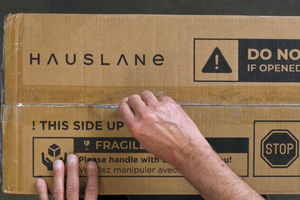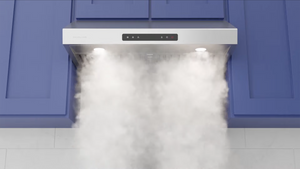Annual Range Hood Inspection Guide
Hauslane range hoods are built to last, and you can keep yours running for years with regular maintenance and inspections. We recommend inspecting your range hood every year to make sure all the parts are working well.
Normal wear and tear can take its toll, and replacing worn or damaged parts can prevent larger problems down the line. Annual inspections are also important for safety, since range hoods are connected to your home’s electrical system.
Here you’ll find step-by-step instructions for your annual range hood inspection, so you can enjoy clean air and fabulous cooking for many years to come.

Step #1: Prepare for the Inspection
Review your product manual and safety guidelines, then gather the necessary tools for your inspection, such as screwdrivers, a flashlight to get a better look at the parts and a ladder or step ladder if preferred.
Disconnect the power so you can perform internal and electrical inspections safely, and lay protective coverings over the counter in case you drop something or things get greasy.

Step #2: Inspect the Exterior and Mounting
Take a look at the overall appearance of the unit. Look for dents, scratches, and discoloration, which you can treat with a product called Rejuvenate. Products like this will help you reduce blemishes without removing the stainless steel coating. Also, look for any grease buildup on the outside so you can clean it.
Next, you’ll want to check the structural integrity of the unit and the mounting. Are the brackets and fasteners still secure? Check for any loosening or damage.

Step #3: Filter Inspection
Different range hoods use different grease filters, which you’ll clean during regular maintenance. You can see step-by-step instructions in our guide for cleaning filters.
Here’s how to inspect different types of filters:
- Grease filters: Remove and examine metal mesh or baffle filters for any clogging, discoloration, or damage
- Charcoal filters (for ductless models): Inspect the active carbon filters and replace them if you see signs of clogging or degradation
- Baffle filters: Made of stainless steel, these are quite durable, but look for excessive grease buildup
- Hybrid baffle filters: Inspect the aluminium mesh to spot excess wear and identify grease buildup for cleaning
You’ll also want to check the filter housing for residue buildup or corrosion.

Step #4: Inspect the Motor and Other Mechanical Components
Now it’s time to go into the unit and check the moving parts for wear and tear, which can happen over the years with normal use.
Use the proper tools to remove the casing and inspect the following items:
- Fans and blades: Look for wear, imbalance, obstruction, and debris
- Motor and assembly: Examine for overheating marks, cracks, or unusual wear
- Internal wiring: Check wiring to make sure it’s secure and that there’s no damage to electrical connections and exposed wires
Next, place the cover back onto the unit, tighten the screws, and plug it back in to review the following:
- Listen for any abnormal sounds in the motor, such as rattling or humming during operation
- Assess the overall stability of the unit while it’s operating at full speed, looking for excessive vibrations that may be caused by misalignment or loose mounts

Step #5: Assess Electrical and Control Systems
Reviewing the electrical systems and connections is vital for any major household appliance plugged into the wall.
Examine the following components:
- Control panel and switches: Test each setting to make sure it works
- Digital displays: Review any digital displays
- Fan speeds: Cycle through each speed to check for consistency and smooth transitions
- Lighting: Ensure any lighting works properly
- Voltage check: Use a multimeter to check voltage levels and ensure they match product specs
- External wiring: Make sure that cords connected to the wall show no signs of damage
What Should You Do if There’s a Problem?
If you find any issue with your Hauslane range hood within the first two years, contact customer support and ask about our 2-Year Warranty. Visit our warranty page to review the details and see what’s covered.








